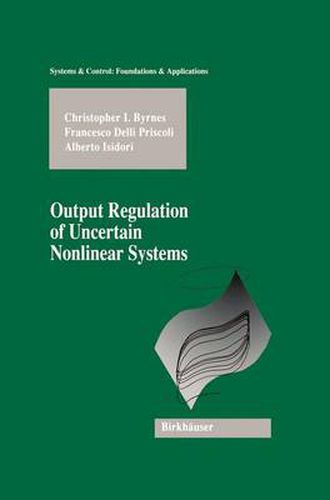Readings Newsletter
Become a Readings Member to make your shopping experience even easier.
Sign in or sign up for free!
You’re not far away from qualifying for FREE standard shipping within Australia
You’ve qualified for FREE standard shipping within Australia
The cart is loading…






This title is printed to order. This book may have been self-published. If so, we cannot guarantee the quality of the content. In the main most books will have gone through the editing process however some may not. We therefore suggest that you be aware of this before ordering this book. If in doubt check either the author or publisher’s details as we are unable to accept any returns unless they are faulty. Please contact us if you have any questions.
The problem of controlling the output of a system so as to achieve asymptotic tracking of prescribed trajectories and/or asymptotic re jection of undesired disturbances is a central problem in control the ory. A classical setup in which the problem was posed and success fully addressed - in the context of linear, time-invariant and finite dimensional systems - is the one in which the exogenous inputs, namely commands and disturbances, may range over the set of all possible trajectories ofa given autonomous linear system, commonly known as the exogeneous system or, more the exosystem. The case when the exogeneous system is a harmonic oscillator is, of course, classical. Even in this special case, the difference between state and error measurement feedback in the problem ofoutput reg ulation is profound. To know the initial condition of the exosystem is to know the amplitude and phase of the corresponding sinusoid. On the other hand, to solve the output regulation problem in this case with only error measurement feedback is to track, or attenu ate, a sinusoid ofknown frequency but with unknown amplitude and phase. This is in sharp contrast with alternative approaches, such as exact output tracking, where in lieu of the assumption that a signal is within a class of signals generated by an exogenous system, one instead assumes complete knowledge of the past, present and future time history of the trajectory to be tracked.
$9.00 standard shipping within Australia
FREE standard shipping within Australia for orders over $100.00
Express & International shipping calculated at checkout
This title is printed to order. This book may have been self-published. If so, we cannot guarantee the quality of the content. In the main most books will have gone through the editing process however some may not. We therefore suggest that you be aware of this before ordering this book. If in doubt check either the author or publisher’s details as we are unable to accept any returns unless they are faulty. Please contact us if you have any questions.
The problem of controlling the output of a system so as to achieve asymptotic tracking of prescribed trajectories and/or asymptotic re jection of undesired disturbances is a central problem in control the ory. A classical setup in which the problem was posed and success fully addressed - in the context of linear, time-invariant and finite dimensional systems - is the one in which the exogenous inputs, namely commands and disturbances, may range over the set of all possible trajectories ofa given autonomous linear system, commonly known as the exogeneous system or, more the exosystem. The case when the exogeneous system is a harmonic oscillator is, of course, classical. Even in this special case, the difference between state and error measurement feedback in the problem ofoutput reg ulation is profound. To know the initial condition of the exosystem is to know the amplitude and phase of the corresponding sinusoid. On the other hand, to solve the output regulation problem in this case with only error measurement feedback is to track, or attenu ate, a sinusoid ofknown frequency but with unknown amplitude and phase. This is in sharp contrast with alternative approaches, such as exact output tracking, where in lieu of the assumption that a signal is within a class of signals generated by an exogenous system, one instead assumes complete knowledge of the past, present and future time history of the trajectory to be tracked.